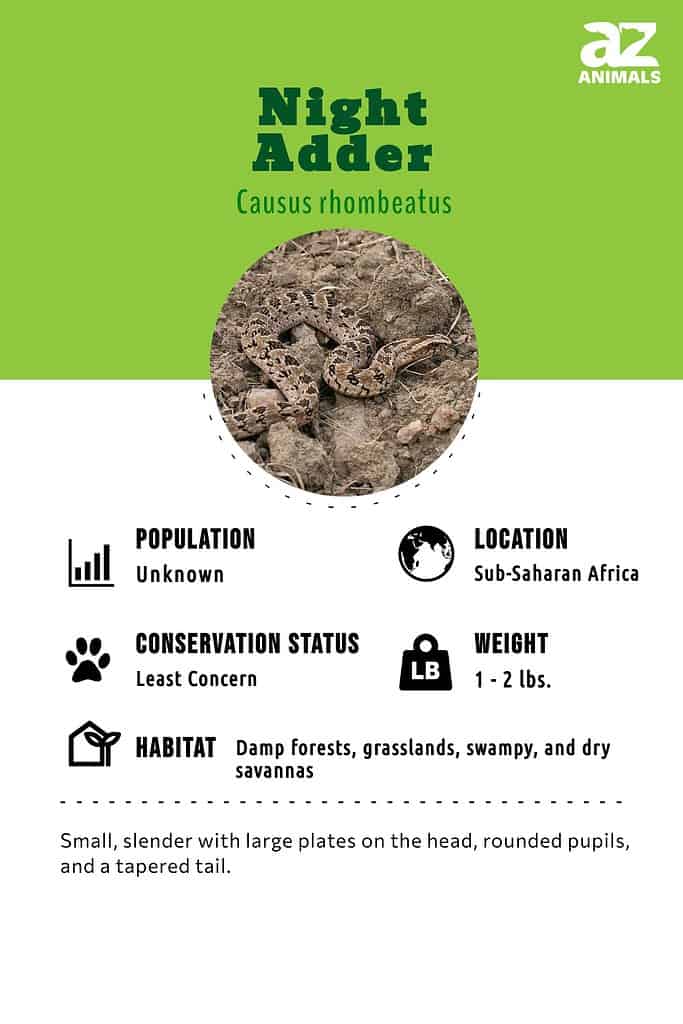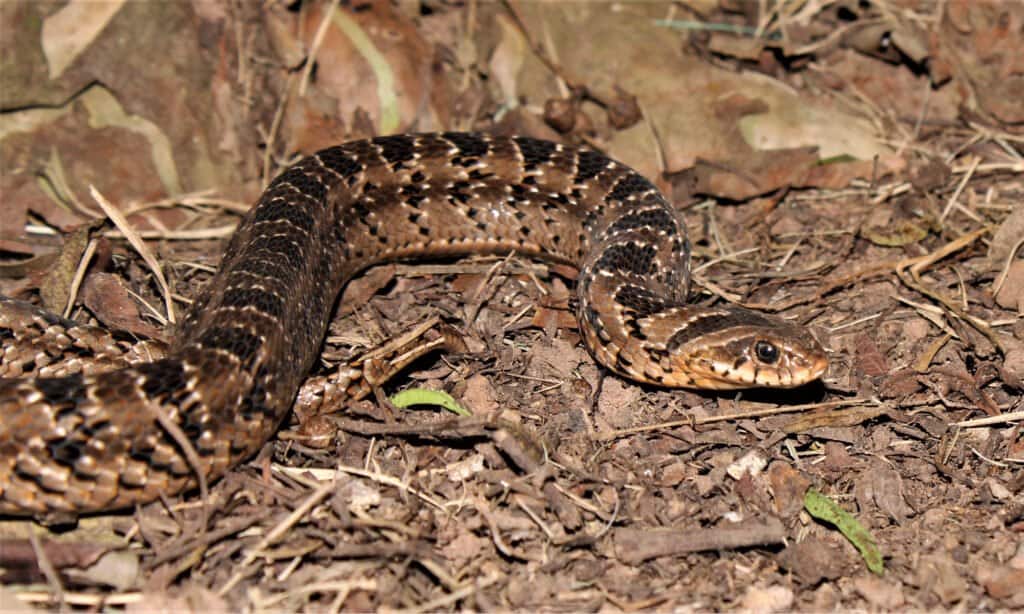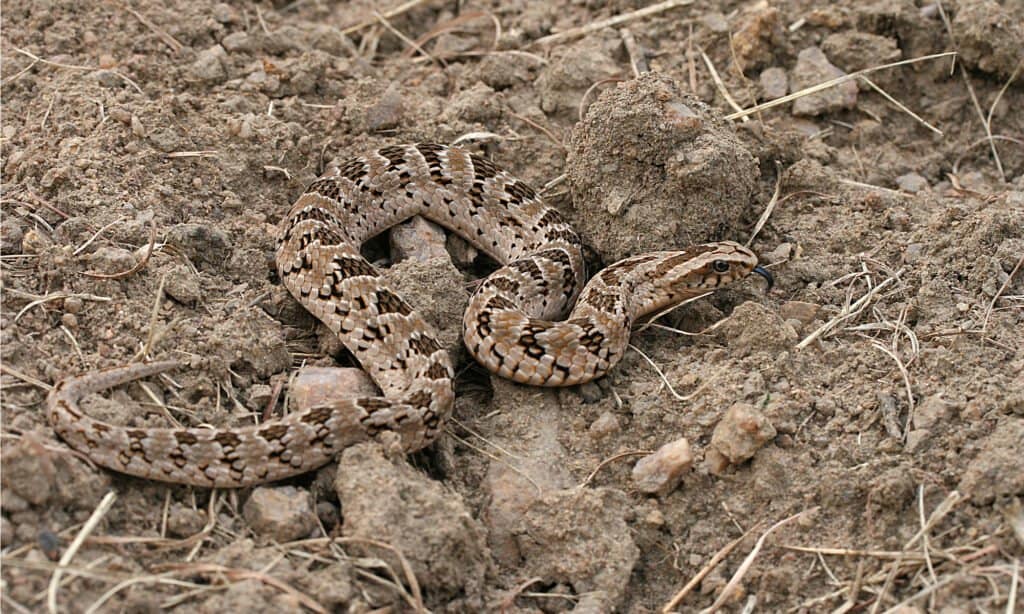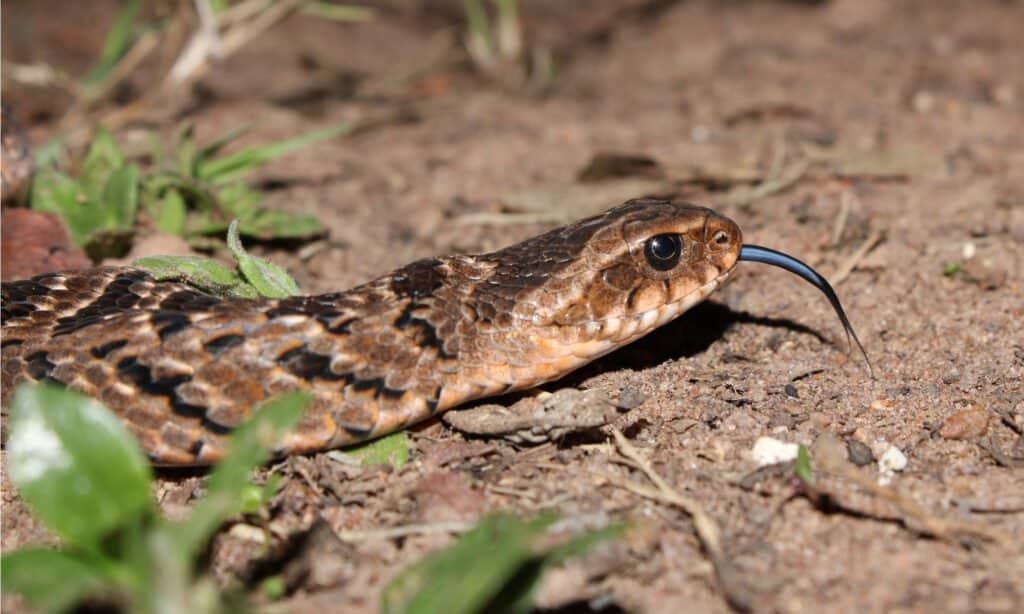Night Adder
Night adders are small, slender snakes that, despite the name, are actually most active during the day.
Advertisement
Night Adder Scientific Classification
Read our Complete Guide to Classification of Animals.
Night Adder Conservation Status
Night Adder Facts
Night Adder Physical Characteristics
- Color
- Brown
- Black-Brown
- Lifespan
- 10 years on average
- Length
- Up to 3.3 feet
- Venomous
- Yes
- Aggression
- Medium
View all of the Night Adder images!
Night adders are small, slender snakes that, despite the name, are actually most active during the day.
Night adders belong to the genus Causus. Seven species of night adders are currently recognized in this genus, including the common rhombic night adder and snouted night adder. Although they belong to the viper family, night adders are distinct from vipers (and even other adders) in many respects. They are comprised of a curious blend of features.
5 Night Adder Amazing Facts
- Night adder females give birth by laying eggs on the ground. This is not unique among snakes, but it is uncommon among adders, which generally give birth to live young. A single female night adder can sometimes produce an average of 24 eggs at a time. They incubate and protect their eggs for approximately four months. Juveniles hatch from the eggs measuring only about 4 or 5 inches long.
- Unlike many other types of vipers, night adders do not have the hinged fangs that enable them to penetrate deep into flesh. The fangs also tend to be much shorter than the typical viper.
- Several species of night adders have very long venom gland that extend all the way down the neck. Despite this, their venom is generally not very toxic.
- The lifespan of the night adder is not well-estimated, but it’s thought to average around 10 years in the wild.
- Night adders are mostly terrestrial in nature, but a few species are known to be good swimmers and climbers.

Where to Find Them
Night adders are primarily found in damp forests, grasslands, and swampy locations throughout sub-Saharan Africa (though a few are found in dry savannas as well). The common rhombic night adder is spread throughout South Africa and surrounding countries, whereas the other species are unevenly distributed throughout the rest of the continent. Most night adders prefer places with plenty of cover to run and hide from dangerous predators.

Night adders are primarily found in damp forests, grasslands, and swampy locations throughout sub-Saharan
Africa
.
©Cormac Price/Shutterstock.com
Scientific Name
The scientific name of the night adder genus is Causus. This is derived from the Greek word kausos, meaning fever or heat. The night adders collectively belong to the viper family.
History and Evolution
Like other snakes, the Night Adder’s ancestors actually had four legs, much like other reptiles, such as lizards, turtles, and crocodiles. As time went on, these prehistoric snakes began to use their legs less and less, and they found being low to the earth was more beneficial than crawling on multiple legs. Thus, they evolved to have smaller legs and eventually they lost them or they became vestigal, which you can still see on some snake species today.
The Night Adder also adapted a manner to defend itself by making loud hissing noises and puffing up its body to scare off would-be attackers. Known for their surprising speed, these snakes are able to strike with such quickness and effort that they may come off the ground totally when they lunge out.
Population & Conservation Status
Population numbers for the night adder have never been properly estimated, but according to the IUCN Redlist, six of the seven species are considered to be least concern, whereas another species, Rasmussen’s night adder, is considered to be data deficient (meaning there is no available information on its conservation status). Numbers mostly appear to be high and stable, but the greatest threat may be habitat destruction and deforestation.
Appearance and Description
The night adder is generally a small, slender snake with large plates on the head, rounded pupils, and a tapered tail. Most specimens measure an average of 1 or 2 feet long, but they can also reach up to 3.3 feet long in rare circumstances. Each species has a slightly different appearance. The common night adder has a tan, yellowish, or light gray body with dark brown rhombic markings along the back. It can be easily identified by distinctive V making on the head and additional black lines near the upper lip. The snouted night adder has a light brown or gray body with 20 or 30 crescent-shaped markings along the back. It also has the black lines along the side of the face. The green night adder, as the name suggests, is the only species with a green body color. This color provides camouflage against the forest.
Here is how to identify the night adder:
- Short, slender body.
- Large plates on the head.
- Rounded pupils.
- Tapered tail.
- All species except for the green adder have brown, yellowish, or light gray skin with dark markings on the back.

The night adder is generally a small, slender snake with large plates on the head, rounded pupils, and a tapered tail.
©Adrian Chinery/Shutterstock.com
How Dangerous Are They?
Despite the presence of well-developed venom glands on the neck, night adders pose minimal danger for healthy human adults. The toxin, which directly attacks healthy cells, should cause little more than pain and swelling with a bit of blistering and discoloration. Cell necrosis is very rare, and few if any deaths have ever been recorded from the toxin of the night adder. However, it has been known to cause hospitalization in children and small animals. If you ever happen to be bitten by a night adder, then you should seek medical attention, even if the bite appears to be mild. Anti-venom is generally not considered to be that effective in the treatment of a night adder snake bite.

If you ever happen to be bitten by a night adder, then you should seek medical attention, even if the bite appears to be mild.
©Cormac Price/Shutterstock.com
Behavior and Humans
If disturbed by a person, the night adder will normally try to run away and hide. Only when it’s cornered will the night adder coil up, start to hiss, and puff up its body to appear more ferocious than it actually is. It also flattens its neck in imitation of a cobra. Even though they’re not highly aggressive, night adder snake bites do occur on a regular basis due to how widespread they are throughout Africa. Most snake bites are usually the result of people accidentally stumbling upon them. An encounter with a night adder should be avoided. While their snake bites generally aren’t too dangerous, they can be painful to deal with.
View all 65 animals that start with NNight Adder FAQs (Frequently Asked Questions)
Are night adders venomous?
Yes, the night adder does produce mild venom that may cause temporary symptoms in people.
How do night adders hunt?
Despite the name, night adders hunt throughout the entire day and not just at night, but there are a few exceptions: for example, the snouted night adder is generally (but not completely) nocturnal in nature. Night adders generally go out in search of prey to kill through their territory. They strike out quickly and inject their venom to subdue the prey. If the prey is small enough, then the night adder will simply swallow the animal whole instead of waiting for the venom to work.
Are night adders aggressive?
Night adders are not very aggressive toward people unless they feel directly threatened. They would rather run away and hide than stand their ground and strike.
Where do night adders live?
Night adders live in grasslands, forests, and swamps throughout sub-Saharan Africa. They need an area with plenty of cover to hide in. Camouflage is among their most important defense against potential predators.
What do night adders eat?
Night adders feed almost exclusively on frogs and toads. They rarely consume anything else. Sometimes, if food is particularly abundant, they will keep consuming food until they are unable to swallow anything more.
What happens if a night adder bites you?
The night adder bite usually results in some moderate pain and swelling. Hospitalizations are fairly rare except in smaller children and animals. Fortunately, death is not known to occur with these species.
How big is a night adder?
The night adder almost never grows any larger than 3.3 feet long.
How can you tell a night adder?
The night adder has a short, slender body with large plates on the head and a tapered tail. Most species except for the green adder have brown, yellow, or light gray skin with dark brown or black markings along the back and sides of the body. Each species tends to have its own unique characteristics. For instance, the snouted night adder is known to have a particularly large and upturned snout.
Thank you for reading! Have some feedback for us? Contact the AZ Animals editorial team.


















